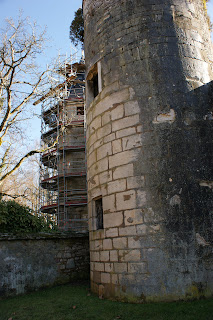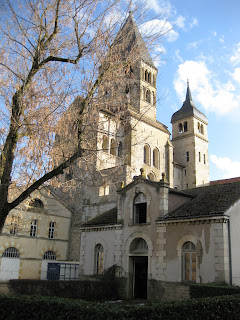We started with a great lunch at the Cafe de France in Beaune, where there are no choices -- everyone is served whatever happens to be the delicious appetizer, salad, main dish, cheese and dessert of the day. The little dining room is packed each day at noon (almost entirely with men, we noticed) all enjoying great French cooking. From there, we went south on back roads (with the GPS of course -- we are never leaving home without it!), taking the long way there, through small villages, past castles and convents and rivers and rock walls.
We came upon two chateaux we'd like to return to when they are open later in the season, which we named Moat Castle (for obvious reasons, although apparently others calls it Château de Germolles) and Duck Castle (for the wonderful ducks who swam to the edge of their pond in hopes of a few crusts of bread. Apparently it also goes by the name Château de Sercy).
Thankfully, we had a few scraps of bread (and even a leftover waffle from lunch) to offer the ducks.
From there, we drove to the village of Taizé, the home of the Taizé community, an international, ecumenical community founded in 1940, and the destination of many modern day youth in search of retreat, worship, and community. From their website:
"Over the years, young adults have been coming to Taizé in ever greater numbers; they come from every continent to take part in weekly meetings. Sisters of Saint Andrew, an international Catholic community founded seven centuries ago, Polish Ursuline Sisters and Sisters of St Vincent de Paul take on some of the tasks involved in welcoming the young people.
"Church leaders also come to Taizé. The community has thus welcomed Pope John Paul II, four Archbishops of Canterbury, Orthodox metropolitans, the fourteen Lutheran bishops of Sweden, and countless pastors from all over the world....
" [Founder] Brother Roger died on 16 August 2005, at the age of 90, killed during the evening prayer. Since then, Brother Alois, whom Brother Roger chose as his successor many years ago, has been the prior of the Community."
In addition to visitors such as the Pope and Archbishops of Canterbury, I think *I* may have gone to Taizé at Easter time in 1993. I remember going with one of the daughters of my host family to a HUGE evening gathering of youth from around the world, and I remember it was a fair drive (more than an hour) from Dijon. I will try to ask Harmels if it was in fact Taizé.
Anyway -- we wanted to stop there on the way to Cluny to see this impressive site (nestled in a beautiful village) and for John to check it out to compare to other modern and former "pilgrimage" sites he writes about in his research.
Here is a bit of what we saw (I didn't want to take close-up pictures of the wonderfully diverse and energtic groups of young people there, so just tried to get a sense of this spiritual place on top of a hill):
While we looked around, the kids played soccer in a field and ended up quite happy but with shoes that looked like this:
It was just another 15 minutes or so to Cluny, which was founded in 910 or 911 AD. I remembered studying this abbey and cathedral in an art history class at university (thank you Prof. Ili Nagy!) and although I knew it was, at one time, the largest Christian building in the world, at first I didn't fully appreciate the vastness of the original site as parts are in ruins today. But then we arrived at this point:
and I could get a sense of just how amazing (especially given the early time during which most of the abbey was built) this site really is. In the foreground of the picture, you can see a map of the cathedral and abbey as it appeared in its heydey. The shaded parts at the bottom and at the top right of the map show buildings that still exist today -- which taken together are less than 10 percent of the original building.
Put another way -- the tower you see in the far distance was part of the original building (and is in the top right corner of the map). The picture is taken from the spot where you would enter the cathedral, at the bottom of the map. Click here to see a sketch of how it would have appeared in all of its glory.
The French Revolution was not kind to Cluny, and in 1793 all of the archives were burned and the church destroyed. From 1798 to 1813, people could go to the abbey to take stone to build their houses.
The kids LOVED exploring the ruins. I would like to go back and do a guided tour of all of the remaining buildings and site, but for a sunny Wednesday afternoon after a few weeks of gray skies, watching the kids leap over the bases of pillars and run among the ruins was just the thing.





























1 comment:
I loved this post. I have never been to Cluny, though it is on the list.I have however been to Conques, another pilgrimage site, which is magnificent. I hope you are able to make it there, although it would certainly be an overnight road trip.
Post a Comment